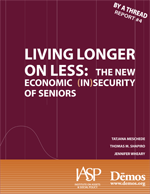Economic security for seniors was built on the three-legged stool of retirement (Social Security, pensions, and savings) at the core of the social contract that rewards a lifetime of productivity. Seniors’ economic security, however, is being challenged by two simultaneously occurring trends: a weakening of the three legs of retirement security income and dramatically increasing expenses, such as for healthcare and housing. Using 2004 national data for seniors age 65 or above, Demos and the Institute on Assets and Social Policy at Brandeis University created the Senior Financial Stability Index (SFSI) to measure the long-term economic security of senior households throughout their retirement years. The fundamental components that frame economic stability for older Americans in the SFSI are Housing Costs, Healthcare Expenses, Household Budget, Home Equity, and Household Assets. This report uses the SFSI to examine the long-term economic security of seniors, depicts current trends and suggests policies promoting the enduring well-being of seniors.
TOP FACTS:
- The Senior Financial Stability Index found that in 2004, 78 percent of all senior households were financially vulnerable.
- Housing: In 2004, 45% of senior households spent nearly a third of their income on housing. 31% either rent or had no home equity to draw on in tough times;
- Healthcare:In 2004, 40% of senior households spent more than 15% of their income on healthcare;
- Budgets: In 2004, 1 in 3 senior households had no money whatsoever left over after meeting essential expenses;
- Assets: In 2004, more than half of all senior households (54 percent) did not have sufficient financial resources to meet median projected expenses based on their current financial net worth, projected Social Security, and pension incomes.

